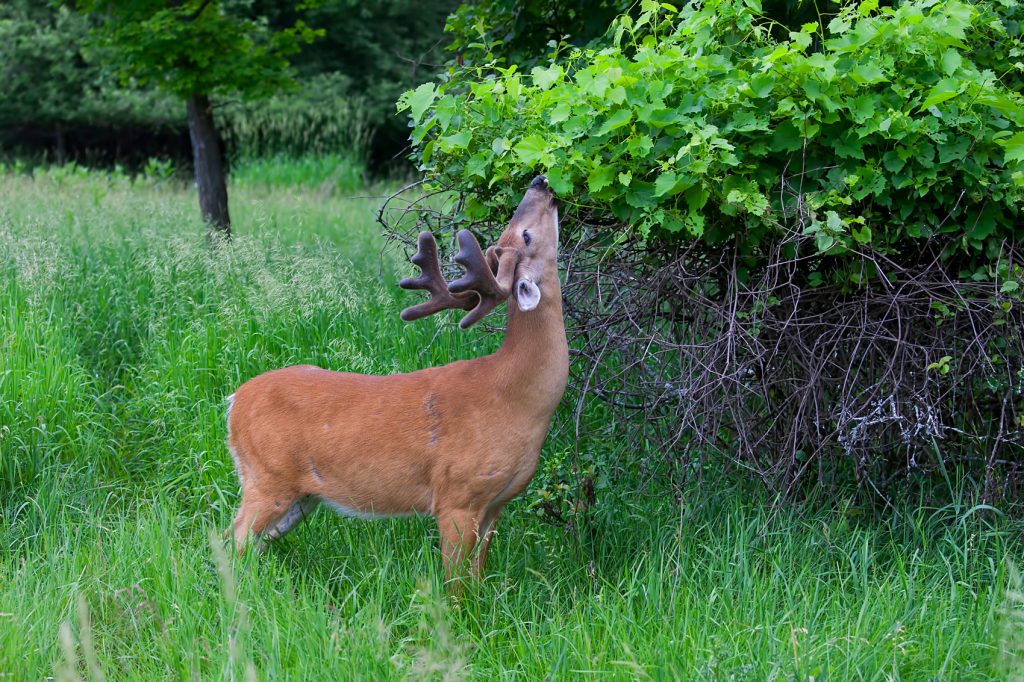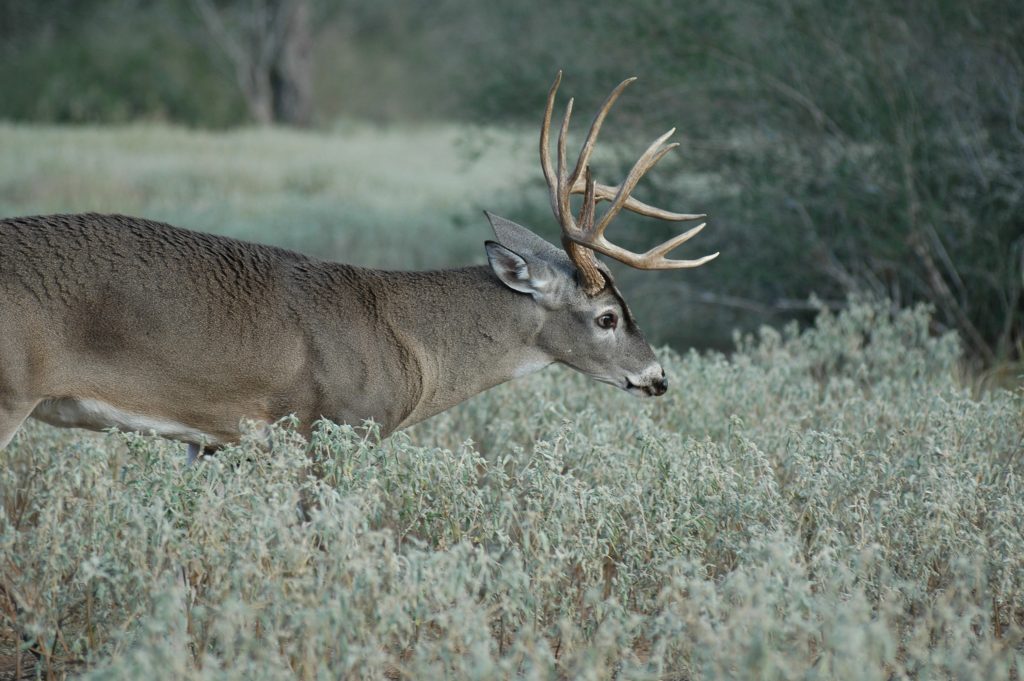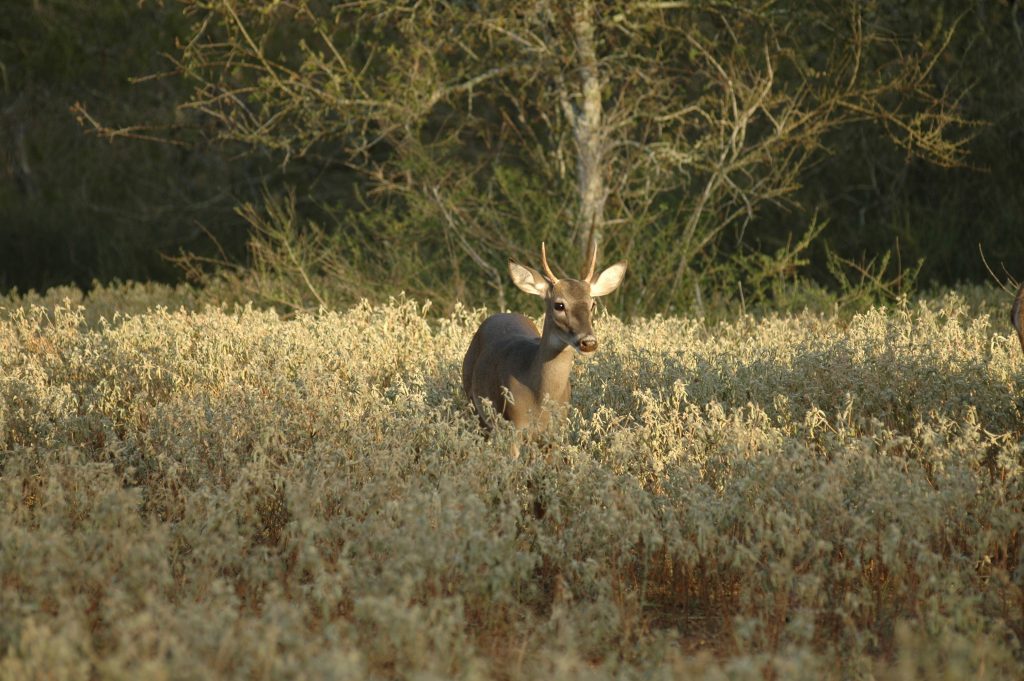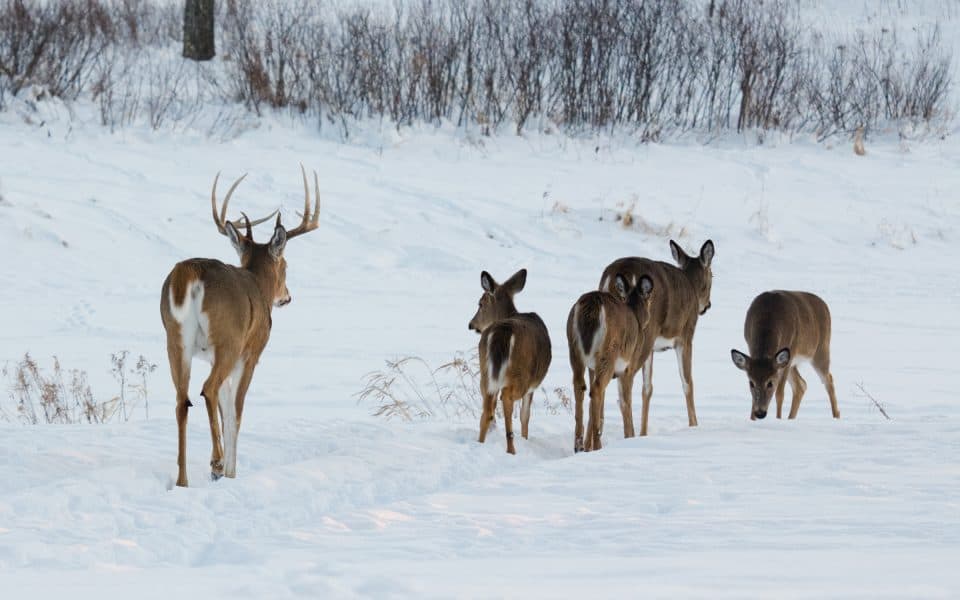The more you know about whitetail behavior, the better your odds of reducing one to possession. Included in that behavior is the local whitetails’ social structure, not only how males and females, young and old interact, but also how those interactions change throughout the year. Many a novice hunter sees a bachelor group of bucks feeding on a field edge, and then returns a month later expecting them to waltz past his stand at sunset, only to be sadly disappointed. What follows is a general overview of the whitetails’ social structure and how it changes throughout the year.
A New Year
We’ll start our calendar with late winter, mostly so we can end it during the hunting season; also because this is when the least segregation occurs. If there is a nucleus to whitetail social structure it is older, matriarchal does. After the rut they form (or re-form) small, loose assemblages that are often family groups consisting of her young of the year and female offspring from previous years. Of course, strangers are welcome too and while sexes are typically segregated throughout the year, even the men are welcome when food is scarce.
With the rut over and day length at it shortest, reduced testosterone levels cause bucks to shed their antlers and lose their aggressiveness toward one another. Depleted by the rut and the bottleneck of winter, deer are desperately seeking enough food to make it until green-up. Every property is different but if food is scarce, as it often is in late winter, you’re most likely to see larger groups together and tolerant of one another, regardless of sex, age or relationship. In addition, they’ll still be together, sometimes gathering in large herds when the first green shoots push through the ground; but that won’t last.
Whitetails Behavior in Spring
Spring is a time of growth. Nutritious green vegetation is abundant and widespread. Deer no longer need to gather in large groups, which poses certain risks. A concentration of deer may attract predators. It can also result in increased stress as deer compete for resources. With an abundance of food, that’s no longer the case. The larger groups disband and individuals disperse into their respective home ranges, and core areas within those. At least the adults do.

Jim Cumming
Last year’s offspring, now yearlings, may linger in their natal home range for a bit. As fetal growth accelerates with the sudden abundance of food and energy, pregnant does grow increasingly intolerant of other deer. Eventually, they’ll drive other does off and seek out a secluded fawning area where they’ll remain for a couple months.
Meanwhile, does experiencing their first pregnancy are now completely on their own for the first time and must find and establish their own home range and core area. The classic scenario is what biologists call a “rose petal pattern.” Imagine a mature doe’s home range as being the eye of the rose. If the area holds enough of the right habitat components – food, cover and water – each successive generation of female offspring will establish a new home range adjacent to, but outside the eye. If you were to plot these home ranges, the pattern might look something like a rose, with each petal representing a different home range.
That’s a bit over-simplified and applies more to new and growing populations where adjacent home ranges aren’t already occupied. Still, younger does tend to set up new home ranges relatively close to their natal home range. By mid-summer, as the fawns get older, female family groups begin to re-form.
Different for Whitetail Bucks

Bob Humphrey
Meanwhile, adult bucks are doing what they regularly do this time of year, which isn’t much. They make a rather poor role model for stay-at-home dads and house husbands, though they may be the envy of all but the most confirmed bachelors. They’re daily routine consists of eating and sleeping. And while they don’t mind the company of other gentlemen, they tend to be rather solitary, except at meal time.
Then, they sometimes form loose assemblages called “bachelor groups,” usually of unrelated individuals. The number and age of bucks in these groups varies from place to place and even day to day. One pasture might have two or three, another a dozen or more different bucks traveling and feeding in relatively close proximity. Interactions are relatively peaceful. Antlers are still in velvet and the days are long but as they grow shorter, so will the tolerance.
Bucks are relatively solitary by nature, but diminishing day length causes an increase in testosterone and a decrease in sociability. The change is gradual as bucks within bachelor groups still interact with one another, sometimes mutually grooming. When velvet is shed, they may begin casual sparring matches, delicately meshing antlers and pushing and shoving one another. Over time, these interactions take on a more serious tone and bucks spend increasingly less time with their peers.
Sometime in the fall, most (about 70%) yearling bucks leave the home range in which they were born and disperse into new and unfamiliar territory. These dispersals are usually in a relatively straight line and average around 5 to 7 miles. It’s unclear precisely what prompts this.
Some yearling bucks disperse in the spring and it’s thought to me mothers driving them off as they get closer to giving birth. Fall dispersal is likely due to an increase in negative interactions with older bucks as the rut draws nearer. Either way, it’s nature’s way of discouraging inbreeding.
From a hunting perspective, this makes yearling bucks particularly vulnerable as they’re entering unfamiliar territory, making them most vulnerable at a time of high risk. That, more than age structure in the population is partly what makes them seem more abundant, and why more are harvested where antler or age restrictions are not enforced.
Whitetail Rut

Mike Rogal
Behaviorally, white-tailed deer exhibit a tending-bond, serial polygamy mating system. As most hunters and managers know, breeding season is linked to photoperiod; as the days grow shorter, does start entering estrous. Bucks have been ready, willing and eager to breed for several weeks and the first whiff of a hot doe pulls the trigger on accelerated activity.
Those casual pushing and shoving matches from a few weeks ago suddenly take on a more serious tone. The dominance hierarchy among bucks with overlapping home ranges has largely been sorted out, but the urge to breed emboldens some bucks. Fighting is dangerous, so the first interaction is often intimidation through body posturing: stiff-legged, ears back, hair bristled up. That and a snort-wheeze are often enough to discourage a potential rival.
Sometimes it’s not enough. Evenly-matched rivals, strangers or bucks with a bad attitude might be more aggressive toward one another. If one doesn’t back down, it may come to blows. The strongest and most aggressive usually wins the battle but that doesn’t necessarily guarantee the prize. A hot doe and the commotion of a fight may attract other bucks that might swoop in and steal a doe away.
A doe remains in estrus for roughly 24-48 hours. Once paired with a buck, the two will remain together until she stands, and lets the buck breed her. During this time, the pair will often seek a secluded area. Whether it’s the doe leading the buck or the buck driving the doe off we don’t know, but it’s a way of avoiding other deer until the deed is done. Then the buck strikes off in search of another potential mate.
The rut in northern areas is more contracted, with peak occurring over roughly over a week to 10 days while in the south it’s more protracted. Most of the does entering estrus at roughly the same time creates a target rich environment for bucks. However, the time spent tending reduces the number of does an individual buck can breed. Furthermore, a doe may breed with more than one buck so twins with different sires is not unusual.
Age structure of the herd can also influence rutting interaction. Young, inexperienced bucks are awkward and an abundance of them can lead to a more protracted rut with a lot of chasing and sometimes wasted energy. Older bucks tend to put these youngsters in their place, leading to a more contracted breeding period, more competition and older, fitter bucks passing on their genes.
As the days grow shorter, the rut winds down but it’s not over yet. Often the younger bucks are worn down or have been weeded out by hunters. Older bucks that bided their time waiting for peak rut are now going full speed ahead but must search farther and wider to find a mate. Does that weren’t bred during their first estrous period will cycle again, possibly causing a second, less intense peak.

Bob Humphrey
Full Circle
As winter sets in the sun rises later, sets earlier and hangs lower in the sky. Bucks are depleted by the rut and does have greater energy demands from the new life growing within. Finding food becomes a priority and all the members of the herd become more sociable. Food scarcity may cause some aggression with older, more dominant deer out-competing younger, more submissive ones, but the general vibe is relatively peaceful. Family and friends get back together and spend the winter as they begin another trip around the sun.








